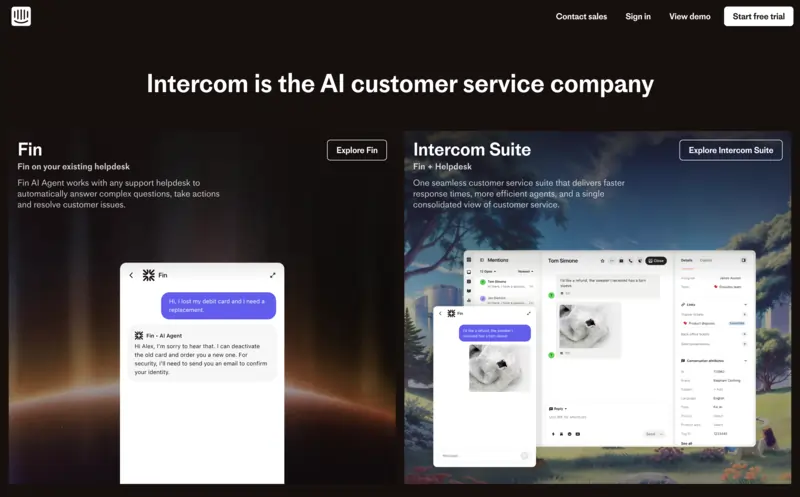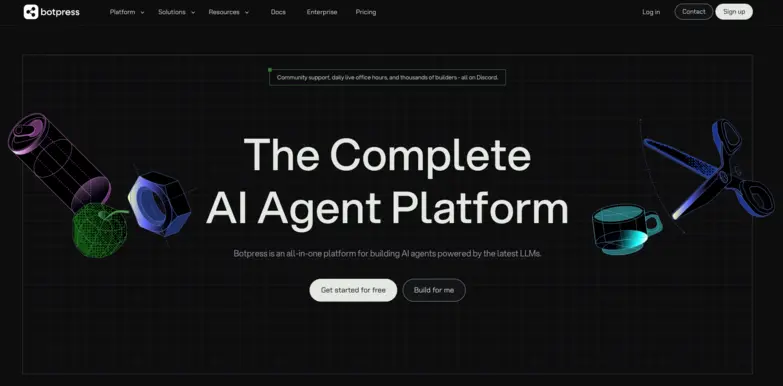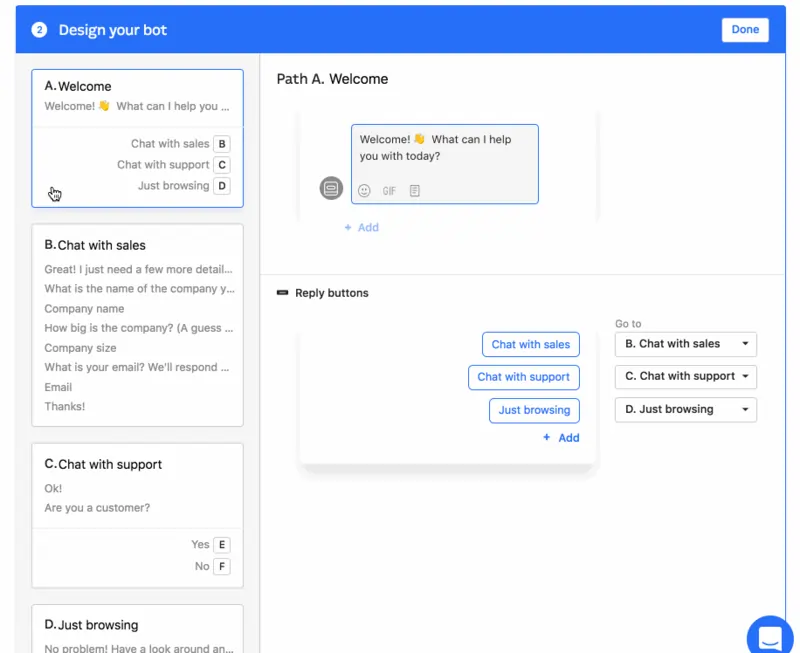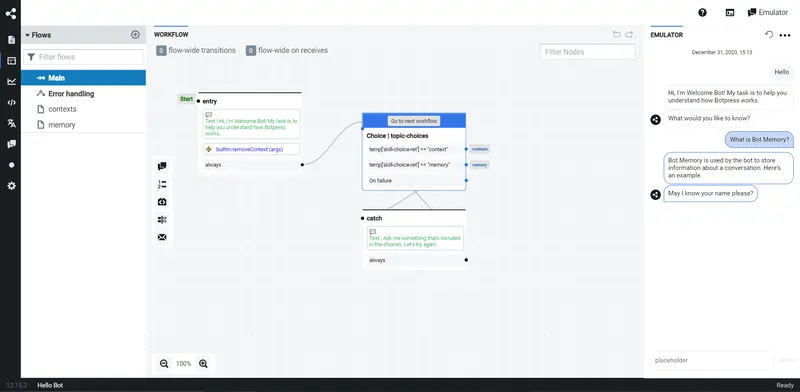Today’s businesses need AI chatbots that do more than answer simple questions. Businesses need AI agents that understand context and scale with customer expectations.
If you're exploring AI for customer service, you’ve probably come across Intercom and Botpress. Both platforms help teams build customer service chatbots, but they take different approaches to conversational AI – from how they manage automation to how much control users have over customization.
But how do they compare? And more importantly, which one fits your conversational AI strategy? Let’s dive into a side-by-side look at Intercom vs. Botpress.
Quick Overview: Botpress vs. Intercom
TL;DR: Intercom is great for teams who require pre-built customer service chatbots and related tools. Botpress is better for teams that want a flexible AI agent builder.
Intercom is a customer service platform with built-in chatbot and automation features. It’s ideal for companies that want to handle common support questions and route issues to live agents.
Intercom’s Fin AI agent automates simple tasks well, but deep customization and integrations with non-native systems requires workarounds.

Botpress is a conversational AI platform for teams who want to go beyond surface-level automation. You can build fully customized AI agents that resolve complex customer issues, connect to CRMs, trigger backend actions, and adapt over time.
With support for custom code, API integrations, and retrieval-augmented generation (RAG), Botpress is ideal for businesses building advanced, scalable AI for customer service.

Feature-by-Feature Comparison
Botpress vs. Intercom Pricing Comparison
TL;DR: Intercom offers polished all-in-one support tools but becomes expensive as teams grow and AI usage increases. Botpress delivers more predictable pricing, especially for growing teams focused on building custom AI agents.
Intercom Pricing
All Intercom plans include a 14-day free trial, and usage-based costs can increase significantly depending on team size and resolution volume.
Intercom uses a seat-based pricing model with additional charges for AI usage. Their Fin AI Agent is priced separately at $0.99 per resolution, with a $49.50 monthly minimum.
Intercom offers three monthly paid plans:
Botpress Pricing
Botpress offers a free plan that includes $5 in monthly AI credits. These AI credits act as a budget for powering smart features like knowledge retrieval and text rewriting in your bots.
Botpress also offers a Pay-As-You-Go option, which lets teams pay only for the AI usage they consume, making Botpress a cost-effective option for businesses.
In terms of paid plans, Botpress offers straightforward pricing tiers:
Integration Capabilities
TL;DR: Intercom includes 450+ native integrations for popular support and marketing tools. Botpress offers 190+ integrations across a variety of platforms and gives teams more flexibility to build custom connections.
Intercom provides over 450+ apps and integrations, including popular tools like Salesforce, HubSpot, and Jira. These integrations include both first-party apps built by Intercom (like Salesforce, HubSpot, Slack, Stripe, and WhatsApp) and over 200 external partner-built solutions. However, building custom integrations requires extra middleware or developer effort.
Botpress supports 190+ native integrations and makes it simple to connect to any system using API calls. Teams can link Botpress with CRMs like HubSpot, support platforms like Zendesk, or internal tools to update records and automate workflows in real time. For more complex bots, Botpress allows developers to build fully custom integrations without relying on third-party connectors.
Use Cases
TL;DR: Whereas Intercom focuses only on customer service, Botpress can be used for any business process automation.
Intercom is used to handle customer support and onboarding inside apps and websites. It’s good at managing chat conversations and routing issues to human agents. It works well for teams that want to improve support and engagement, but Intercom isn’t designed for automating tasks beyond customer-facing roles.
Botpress is for teams that want to automate more than just customer support. Botpress handles customer service, lead generation, HR support, IT helpdesk tasks, and more. Businesses use Botpress to create AI agents that work across multiple departments and automate full workflows rather than just chat.
Security Features
Community & Support
TL;DR: Intercom offers standard support and training through its Help Center and paid services. Botpress adds more hands-on support and a large, active developer community.
Intercom provides support through its Help Center, email, and live chat (for paying customers). Users can access guides and webinars through Intercom Academy. For more advanced help, Intercom offers paid implementation and support services. However, live support depends on the user's plan, and community engagement is limited.
Botpress offers both structured learning and real-time support. All users can access documentation, tutorials, and the Botpress Academy.
Botpress also offers other avenues of support, including:
- A 30,000+ member Discord for peer help and daily live AMAs with Botpress experts
- Max, the Botpress Support Chatbot, for instant troubleshooting
- Live Chat Support for Plus plans and above
- Dedicated Customer Success teams are available for Team and Enterprise plans
Customization & Flexibility
TL;DR: Botpress gives teams full control over how their AI agents behave and connect to systems. Intercom allows limited customization within its no-code environment but restricts backend logic and advanced workflows.
Botpress and Intercom both:
- Allow customization of conversation flows and user experiences
- Support integration with external systems and APIs
- Enable teams to modify bot behavior based on specific business needs
Intercom lets teams customize chatbot flows, appearance, and behavior using its visual builder. It also supports API calls for basic tasks like pulling customer data or triggering messages. However, it doesn’t allow custom code or deep backend control. This makes Intercom best suited for standard support workflows.

Botpress is built for developers and technical teams who want full flexibility. It allows custom logic with JavaScript or TypeScript, lets you call any API, run scripts, and store data across sessions. Teams can create advanced workflows and tailor every part of the chatbot – both frontend and backend.

Memory Duration
TL;DR: Intercom chatbots don’t have built-in long-term memory, while Botpress bots can remember users and context across sessions.
Intercom chatbots use information during a single session, like a customer’s name or question history. But they don’t have native memory between sessions. To remember user data across chats, teams need to connect Intercom to a CRM or database and pull that data at the start of each conversation. This adds complexity for personalized experiences.
Botpress includes built-in memory. Bots can remember returning users, past issues, and preferences without needing external systems. Developers can control what’s stored and for how long, allowing for more personalized support, especially for use cases with repeat customers or multi-step processes.
Knowledge Capabilities
TL;DR: Intercom is built for quick setup using support content from help centers. Botpress gives teams more control and flexibility with access to diverse data and real-time responses.
Intercom uses the team's existing help center content (like articles from Intercom’s Help Center) to train its AI agent, Fin. It can pull answers from public docs and FAQs to respond to customer questions. Intercom also supports connecting to tools like Zendesk and Guru, but it doesn’t support unstructured data or complex external sources beyond these supported apps. Fin doesn’t natively access live backend data or run advanced logic.
Botpress works with static knowledge like FAQs but also handles live, structured, and unstructured data, including CSVs, PDFs, APIs, and databases. Its built-in Retrieval-Augmented Generation (RAG) engine lets bots search across large datasets and generate responses in real time. Bots can also call APIs to pull up-to-date information, making Botpress ideal for teams that want smart, dynamic support tied to their internal systems.
Which platform is better for my business?
1. 24/7 Multilingual Support for a Global Travel Company
Key Problem: Providing 24/7 multilingual support across channels for a global customer base.
TL;DR: Intercom handles multilingual FAQs and live agent handoff but Botpress offers stronger multilingual NLU, personalization, and backend flexibility.
Amir leads customer support at a global travel booking platform. His team deals with time-sensitive inquiries like flight changes, cancellations, and travel advisories – often in multiple languages and across channels like WhatsApp, mobile apps, and the company website. Amir needs:
- A chatbot that can understand and respond in multiple languages
- Consistent experience across all platforms
- Ability to access real-time booking data and perform actions like cancellations or itinerary changes
Intercom supports 43+ languages through its Fin AI agent, which can pull answers from existing help articles and FAQs in supported languages. Fin works across platforms like Messenger, web chat, and mobile apps, and integrates with tools like Zendesk or Salesforce for support workflows. However, Fin is best for handling straightforward FAQ-style content. It doesn’t support complex, personalized multi-turn conversations or built-in memory across sessions. Integrating with backend systems like booking databases requires custom development or middleware.
Botpress supports 100+ languages with customizable NLU and localized responses. It integrates directly with WhatsApp, mobile, web, and custom channels, and lets Amir’s team design dynamic flows that adapt to language, user profile, or booking data. With built-in memory, Botpress bots can remember prior interactions and ticket history, making follow-ups smoother and support more personal. Plus, its tiered pricing and on-premise deployment options make it ideal for large-scale teams.
In short, for multilingual, multi-channel support with automation, memory, and backend access, Botpress is the more suitable solution.
2. Subscription SaaS Customer Support Scaling
Key Problem: A fast-growing SaaS company wants to deflect basic technical support and billing inquiries without hiring more agents.
TL;DR: Intercom handles support automation well inside its own ecosystem, but Botpress offers more backend flexibility and persistent memory for growing SaaS teams.
Sam is the Head of Support at a rapidly growing B2B SaaS company. His team handles a flood of tickets related to login issues, billing confusion, and onboarding questions. To keep up without hiring more agents, Sam needs:
- A chatbot that can answer repetitive technical and billing questions
- Easy deployment within Zendesk and Intercom workflows
- Backend integration with CRM and billing systems like Stripe or HubSpot
Intercom offers automation through its Fin AI agent, which can resolve common questions using help center content and escalate to human agents when needed. It integrates smoothly with tools like Zendesk and HubSpot, making it easy for Sam to connect the chatbot to existing workflows. However, Fin relies on predefined content and doesn’t retain context across sessions. Personalized conversations or multi-step flows – like retrieving billing history or updating payment methods – require additional engineering effort. Additionally, Intercom’s per-resolution pricing can add up as usage grows.
Botpress delivers more flexibility out of the box. It includes persistent memory, which lets the bot remember user details and preferences over time. Sam can build flows that connect directly to Stripe APIs to check billing status or manage subscriptions in real time. With custom JavaScript or TypeScript nodes, Botpress supports advanced automation like tagging conversations for agent review or sending follow-up onboarding messages. It fits easily into helpdesk systems and scales without increasing costs per ticket.
For teams like Sam’s that need deeper backend integration, personalized interactions, and pricing that scales, Botpress is the ideal choice.
3. Automated Order Management for a D2C E-commerce Brand
Key Problem: Automating post-purchase support like tracking, returns, and product questions.
TL;DR: Intercom helps with basic e-commerce support using help content, while Botpress offers deeper automation, personalization, and real-time integrations.
Priya leads CX at a D2C e-commerce brand that just expanded internationally. Her team handles thousands of queries about order tracking, returns, and product details every week. Priya needs:
- A chatbot that can guide customers through returns and track orders in real time
- Seamless integration into Shopify and web chat
- Support for automating repetitive tasks like refund requests or FAQs
Intercom offers tools like Fin AI for answering product FAQs using connected help center content. It integrates with Shopify and major helpdesk platforms, and offers visual workflows for basic automations. However, Fin AI doesn’t support persistent memory, so customers must re-enter information every session. Custom logic, like multi-step workflows for checking order status, issuing refunds, or tailoring product suggestions, requires developer setup and additional configuration. Intercom’s pricing is also usage-based, which can be costly during high-traffic periods like holiday sales.
Botpress, in contrast, gives Priya full control over automation. The bot can connect directly to Shopify APIs to pull real-time order status, guide customers through return flows, or even handle exchanges. Botpress includes memory across sessions, so it can recall purchase history or user preferences. Priya’s team can also build smart flows that adapt based on product availability or return eligibility. Natural language filtering helps customers find specific items quickly in large catalogs. And with predictable monthly pricing, Botpress stays cost-effective as the brand scales internationally.
Bottom line? Intercom works for basic post-purchase help using static content, but Botpress is better for Priya’s team if they need real-time data, personalized support, and deeper automation without skyrocketing costs.
4. Heavily Regulated Industry Support (e.g. Healthcare)
Key Problem: Automating inquiries while meeting strict compliance and audit needs.
TL;DR: Intercom offers basic security and HIPAA compliance with a BAA, but Botpress gives teams more control with on-premise deployment, audit logs, and customizable data handling.
Marcus is responsible for customer experience at a healthcare provider. His team wants to automate scheduling, policy questions, and coverage info while staying compliant with HIPAA and regional data laws. Marcus needs:
- A secure chatbot that protects patient data
- Full audit logs and access control
- Option to deploy on-premise for compliance with internal security policies
Intercom can be made HIPAA-compliant with a signed Business Associate Agreement (BAA), and it offers data encryption and enterprise-grade infrastructure. However, Intercom is a fully cloud-hosted platform, so Marcus’s team cannot host the solution on their own infrastructure. Advanced audit logging and detailed access policy customization are limited compared to dedicated enterprise platforms. Intercom workflows can connect with scheduling and healthcare tools through APIs, but persistent memory or contextual awareness between sessions may require third-party database support.
Botpress includes built-in memory, full audit logs, and role-based access control by default. Most importantly, Botpress can be deployed on-premise or in a private cloud, giving Marcus’s team complete control over data storage and handling. This is especially useful for healthcare providers that need to comply with internal IT policies or data residency laws. With Botpress, developers can securely build workflows like appointment scheduling or insurance checks while protecting patient data using encrypted memory.
For teams in regulated industries that need flexible deployment, complete data control, and enterprise-grade compliance, Botpress is the stronger and more adaptable option.
The Bottom Line: Botpress vs Intercom
Botpress and Intercom offer powerful tools for automating customer service, but they serve different business needs.
Intercom is a strong choice for companies looking for an all-in-one customer service platform that includes live chat, help desk, and AI chatbot capabilities in a single tool. Its Fin AI agent helps automate common support tasks and can be embedded easily into Intercom’s broader support workflows. Its pricing scales per seat and per resolution, making it less cost-effective for high-volume or deeply technical automation needs.
Botpress is ideal for businesses that want full control over their AI agents. It’s built for teams that need to create advanced conversational experiences, from complex customer support workflows to internal automation. With features like persistent memory, API-level backend integrations, on-premise deployment, and support for any LLM, Botpress gives developers the freedom to build highly customized, scalable bots. Its transparent pricing and usage-based options also make it more budget-friendly as automation needs grow.
FAQs
1. Is Botpress suitable for non-technical teams without developers?
Yes, Botpress is suitable for non-technical teams thanks to its no-code Studio, which allows users to build and manage bots using drag-and-drop flows and natural language prompts. However, for advanced use cases like custom API integrations or backend automation, having access to a developer can unlock the platform’s full potential.
2. Which platform is better for short-term experimentation with chatbots?
Intercom is better suited for short-term experimentation if you're already using its customer support suite, since its Fin AI agent can be deployed quickly with existing help content. Botpress is more flexible for custom experimentation, especially if you're testing unique use cases or different AI models.
3. What kind of ongoing maintenance do these platforms require?
Botpress bots may require periodic updates to workflows, knowledge bases, and API connections, especially if your systems or business logic change. Intercom bots need less technical maintenance but may require frequent content updates and configuration tweaks.
4. What happens to user data when I delete a bot from either platform?
When you delete a bot in Intercom, conversation and user data may still be retained in your workspace unless you manually delete associated records. In Botpress, deleting a bot removes its flows and configurations, but you must also clear memory tables or user data explicitly to ensure complete removal.
5. What’s the best way to prototype a chatbot use case before full deployment?
The best way to prototype a chatbot use case is to build a minimal version focused on a single high-impact task (e.g., password resets or order tracking) and test it in a limited environment like a staging site or internal channel. Both Intercom and Botpress allow sandbox-style deployments, but Botpress gives more control over user flows and integrations during prototyping.
.webp)





